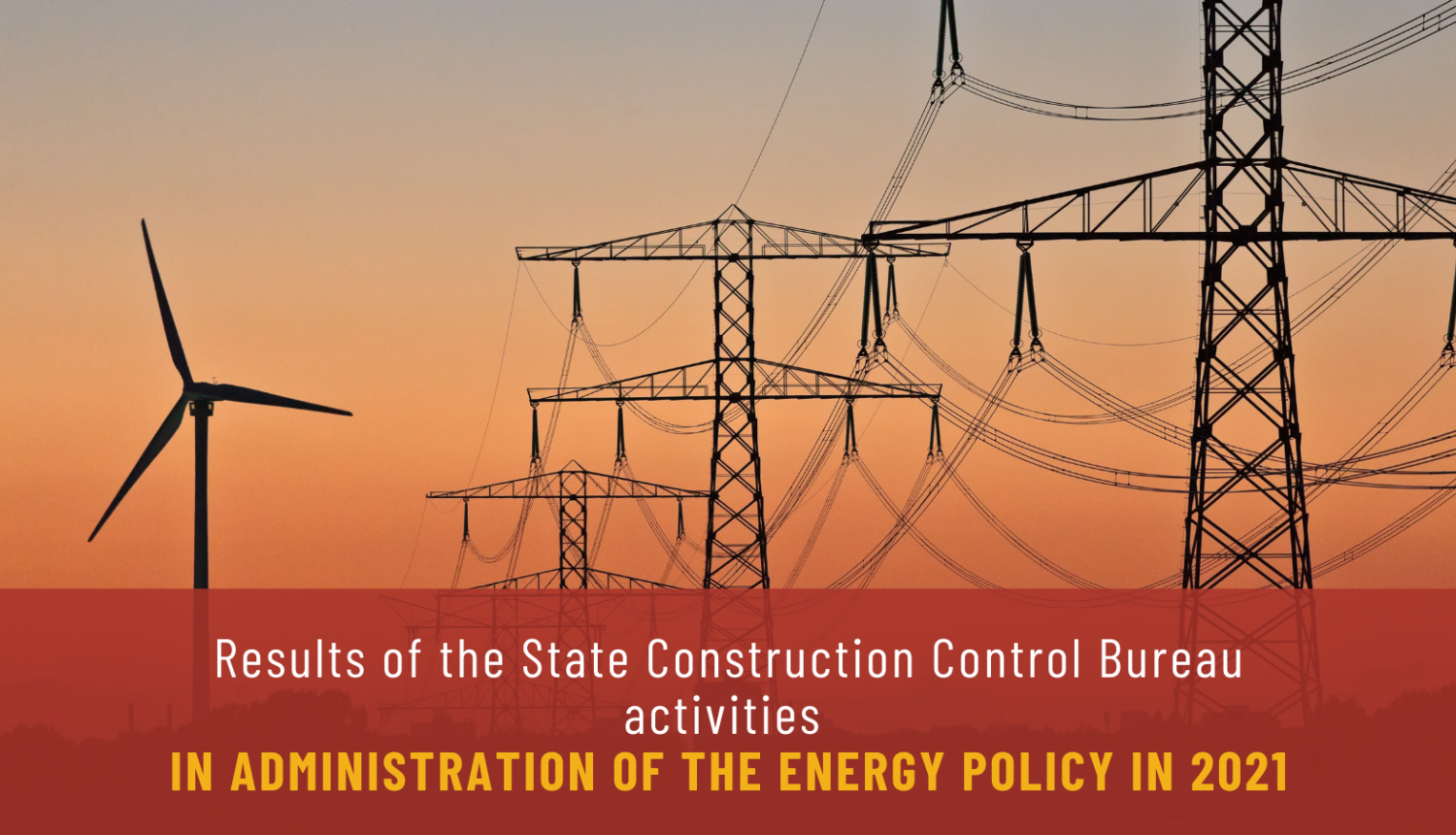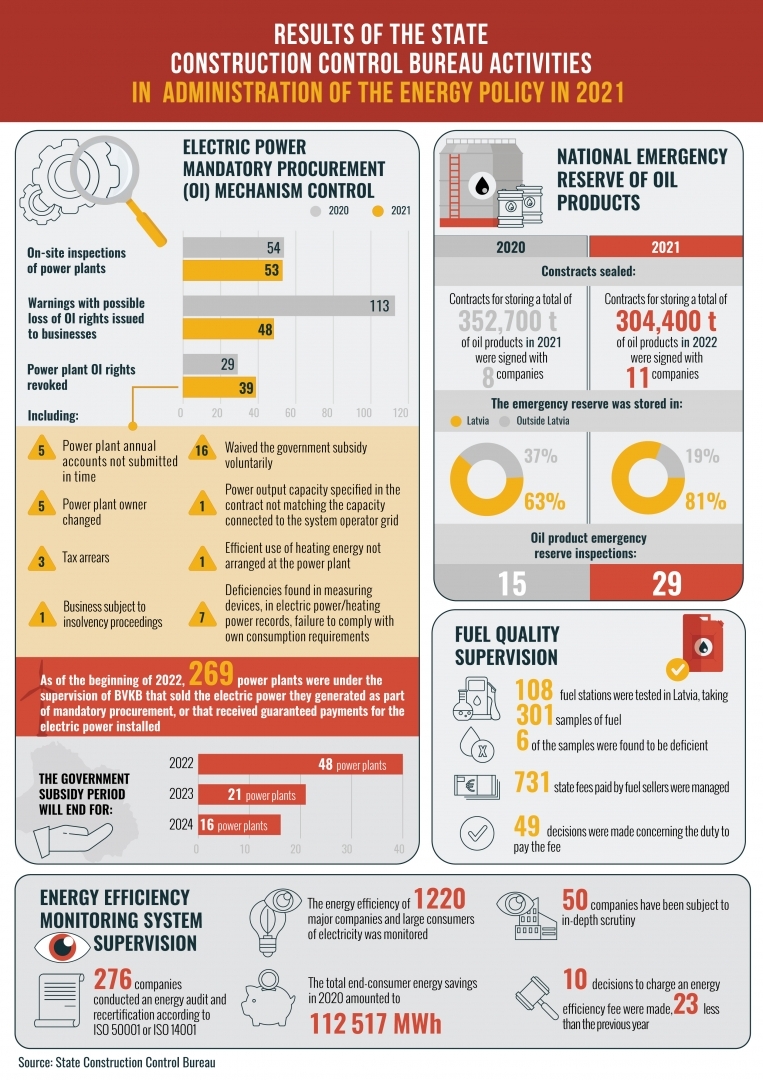It’s been two years since the State Construction Control Bureau (SCCB) began performing the energy policy administration function. In 2021, SCCB focused more on managing the mechanism of mandatory procurement (MP) of electric power, supervising energy efficiency compliance and improving its monitoring system, testing the quality of fuel, providing the national emergency reserve of oil products, and launched the new Protected User Data Information System. The overall results of SCCB activities show a positive shift in the understanding of energy requirements among businesses.
In 2021, SCCB assessed the annual accounts of 311 power plants, and conducted on-site inspections of 53 power plants that receive state subsidies in the form of electric power MP. The reviews of annual accounts, the inspections and the tax assessments paid by the companies operating the plants resulted in 48 warnings of possible loss of MP rights, as compared to 113 a year before that. SCCB revoked the MP rights of 39 power plants last year, while for 7 of the power plants, the state subsidy period expired.
As part of monitoring the energy efficiency, of major companies, big consumers of electric power, parties in charge of energy efficiency scheme duties and public governance, the bureau conducted an in-depth inspection of 50 entities that are part of the energy efficiency monitoring system (major companies, big consumers of electric power, municipal governments) to verify that they fulfil their duties, assessing the completion of registered measures for potential energy savings in comparison to energy efficiency measures conducted every year, to confirm that the measures were implemented at specific addresses, and to discuss each entity’s potential for improving energy efficiency in the future. 10 decisions to charge an energy efficiency fee were made for large consumers of electric power that failed to comply with the Energy Efficiency Law, which is 23 less than the previous year, which indicates the bureau’s success in working with businesses.
According to information submitted by businesses, as well as government and municipal bodies, the overall amount of energy saved in 2020 was 112,517 MWh. In terms of energy savings during the first requirement period between 2014 and 2020, the government was found to have met its requirements. According to Directive 2012/27/EU, Latvia was to save a total of 9,896 GWh in end consumption of energy, while the total savings achieved so far, based on the information collected by the bureau, have reached 12,525 GWh, achieving the target of 126%.
‘The current situation on the energy market clearly shows that we need measures to improve energy efficiency. We see especially high potential in promoting energy efficiency in municipalities and the public sector, which will make it possible to reduce costs as a result. In 2022, we will focus on local governments,’ head of SCCB Svetlana Mjakuškina emphasised.
750 central government buildings with a total area of 1,560,732 m2 were recorded in 2020. During that period, 28 buildings, with an area of 106 683 m2, 7% of the total, underwent renovations. Thus, the 3% renovation target for 2020 was reached and exceeded.
One of the biggest tenders conducted by SCCB ended in success in 2021, resulting in the procurement of a national emergency reserve of oil products for this year. A general agreement was concluded with 11 companies, which will store 295,400 tonnes of oil products as a national emergency reserve. In 2022, 81% of that reserve will be stored in Latvia, which is 18% more than a year prior, and already exceeds the strategic goal of increasing the share of the national emergency reserve of oil products kept in Latvia to 75% in 2023. In 2021, in addition to monitoring the reserve, the bureau began inspecting the quality control to service providers handling the storage of the national emergency reserve.
In 2021, SCCB sampled and tested the fuel sold at 108 fuel stations all over Latvia. The fuel quality situation in the country is good. Of the 301 samples tested, only less than 2% (i.e., 6 samples) were found to have deficient quality, 3 of these were samples of petrol, and 3 were of diesel fuel. The testing of fuel quality takes place in an accredited laboratory.
The new Protected User Data Information System launched last year, collecting data about protected users and providing sellers of electricity with information about people who are entitled to benefits for reducing their electricity bills. Protected users include families with more than two children, people with Group I disabilities, families with disabled children, struggling and low-income households. At this point, it can be concluded that changing the mechanism for receiving this aid has made it possible to identify and cover a broader group of protected users. The number of protected users who received aid in December was 92,434. This is ~30% more than prior to the introduction of the system. ‘Implementing the new system has made it possible for every seller of electricity to provide the protected user service. Right now, two companies provide one: AS Latvenergo (Elektrum) and SIA Tet, which is a clear indication of their social responsibility,’ head of SCCB noted.




